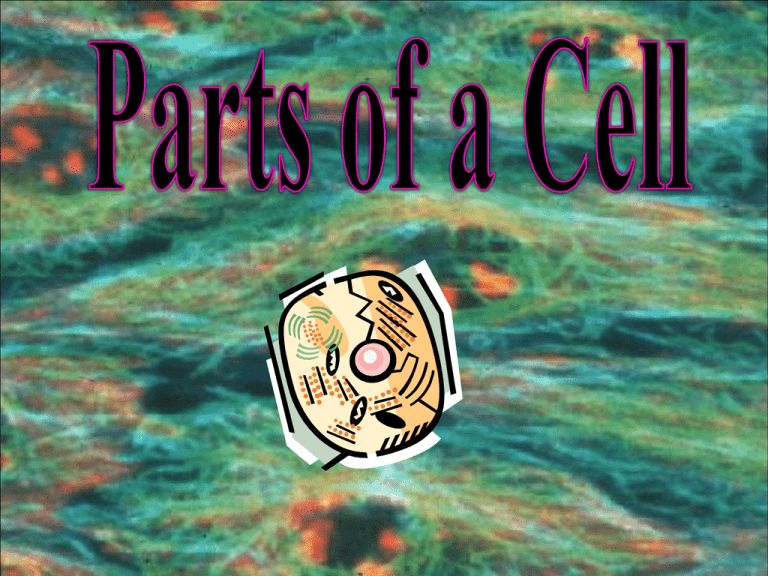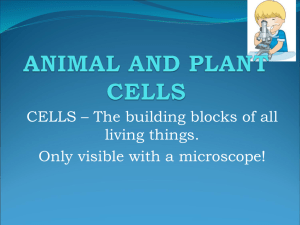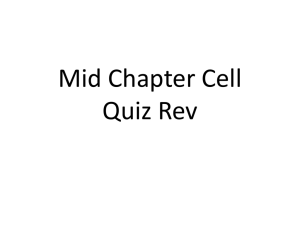organelles
advertisement

What are cells? Organism An organism is made of organ systems. Organ systems are made up of organs Organs are made up of tissues Tissues are made up of CELLS! Brainpop: Cells & Cell Structures Organ System Organ Tissue Cells!!!! The Cell Theory 1. All living things are made of cells. 2. Cells are the basic units of structure and function in living things. 3. Living cells come only from other living cells. Cells Cells are made up of organelles. Organelles are like tiny organs. Each organelle has a job to do (or a specific function) just like our organs. The organelles work together to keep the cell alive and healthy. Animal Cell Plant Cell What are the functions of the organelles? • Read each slide. • Take notes by filling in blanks on your sheet. • AFTER ALL NOTES ARE DONE, get your sheet of picture clues to cut out and glue in the appropriate box on your sheet. Cell Wall • Plant cells only • Gives plants their shape, structure, support, and protection • Surrounds the cell membrane • Allows H2O, O2, and CO2, to pass in and out of the cell Cell Membrane • A continuous, almost invisible structure surrounding the cell • Supports & protects the cell • Controls movement of materials in and out of the cell Chloroplasts • Plant cells only • Uses energy from the sun to make food for the plant through photosynthesis • Where photosynthesis takes place • Power generator for the plant • Give plants their green color Cytoplasm • The cell’s environment or inner space. • Mostly made of water and contains organelles • The jellylike material outside the cell nucleus. Mitochondria • Powerhouse of the cell. Supplies energy that the cell needs. • Breaks down sugar molecules into energy • Need oxygen to make energy and give off carbon dioxide as Nucleus • The cell’s computer, brain, or manager. Uses DNA to control the cell’s activity • Contains all the information the cell needs to do specific jobs, grow, and divide • Information is stored in DNA molecules • Contains the nucleolus which makes ribosomes • Determines what proteins will be made Lysosomes • Cell’s recycler. Breaks down large food and digests old cell parts. • Contains enzymes which break down the proteins Ribosomes Protein • Produces protein which is the Product of the cell • Cells need protein to survive and grow Protein Vacuoles • Storage bubbles found in cells. • Much larger in plant cells. Store food or nutrients a cell might need to survive. • Store waste products so the rest of the cell is protected from contamination. Packs Golgi Bodies • Packs and carries proteins in little bubbles that separate and float into the cytoplasm. • Prepares the proteins for use or delivery outside the cell Endoplasmic Reticulum (E.R.) • Transportation system of the cell. Carries material through the cell. • Rough ER has ribosomes attached to it so the proteins they make can be released directly into the ER for transport • Smooth ER collects things and contains them Nuclear Membrane • Protects and guards the nucleus. Allows materials to pass in and out. • Keeps the DNA inside the nucleus • Allows other materials to pass in and out of the nucleus THE DIFFERENCE BETWEEN ANIMAL & PLANT CELLS Can you remember the function of each? Protein Cut out the symbols and glue them next to the correct cell part. Organelles Cell Wall Cell Membrane Chloroplasts Cytoplasm Mitochondria Nucleus Lysosome Ribosome Vacuole Golgi Body Endoplasmic Reticulum Nuclear Membrane Cell Functions Plant Animal Picture









